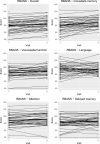Cognitive Function During Opioid Tapering in Patients with Chronic Pain: A Prospective Cohort Study
- PMID: 33363405
- PMCID: PMC7754260
- DOI: 10.2147/JPR.S273025
Cognitive Function During Opioid Tapering in Patients with Chronic Pain: A Prospective Cohort Study
Abstract
Purpose: Evidence for efficacy and safety lacks for long-term opioid therapy in patients with chronic non-cancer pain and adverse effects, including affection of cognitive function and quality of life, is of concern. We aimed to investigate cognitive function and health-related quality of life in patients with chronic non-cancer pain during opioid reduction.
Patients and methods: At two multidisciplinary pain centers, all patients with planned opioid reduction were screened for eligibility. Cognitive function was assessed using the Repeatable Battery for the Assessment of Neuropsychological Status (RBANS) and Trail Making Test A and B. Health-related quality of life was assessed using Short Form-36 (SF36) and Hospital Anxiety and Depression Scale (HADS).
Results: We included 51 participants and 40 participants attended follow-up of median 254 (IQR 106-357) days. Baseline RBANS score was 82 (IQR 65-93) with reference population norm value of 100 (SD±15). Daily opioid consumption was reduced from median 80 (IQR 45-161) oral morphine milligram equivalents to 19 (IQR 0-60) mg. RBANS score estimate increased by 6.2 (95% CI 3.1-9.3, p=0.0004) points after tapering. No differences were observed for Trail Making Test times, HADS or SF36 scores.
Conclusion: Generally, cognitive function showed minor improvement after opioid tapering with stationary health-related quality of life, depression and anxiety scores. The clinical significance is unclear, as no minimal clinically important difference in RBANS score is available.
Keywords: chronic non-cancer pain; chronic non-malignant pain; cognitive dysfunction; cognitive impairment; memory; multidisciplinary pain center.
© 2020 Laigaard et al.
Conflict of interest statement
The authors report no conflicts of interest for this work.
Figures
References
LinkOut - more resources
Full Text Sources



